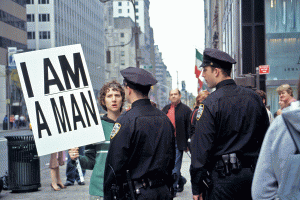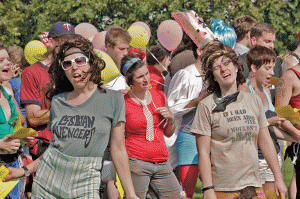« Features
Sharon Hayes / Love is Just a Battle Away

Sharon Hayes, In the Near Future (detail), 2009, multiple-slide-projection installation, 13 x 35mm slide projections. Courtesy the artist and Tanya Leighton Gallery, Berlin.
By Jeff Edwards
Sharon Hayes’ art is stunning for the way it both reflects and strives to transcend the divisive political climate we’ve made for ourselves. Though her works are often concerned with specific controversies and transient cultural moments, their apparent single-issue focus can be misleading. Across a broad constellation of performances, installations, and actions dealing with gender, politics, communication, and language, Hayes gets down to the bedrock intellectual and emotional qualities that unite people across political divides, without downplaying the very real concerns that give rise to activism.
Some of Hayes’ most compelling art centers on identity politics and gay rights, two issues that deeply affected her when she first hit the New York art scene at the height of the AIDS crisis. These works contain a beautiful mixture of the anthropological and the personal. Her 1998 performance The Lesbian transformed material gathered during a nationwide trip across lesbian America into a sly documentary parody designed to interpret lesbian culture for curious outsiders. The more recent Revolutionary Love: I am Your Worst Fear, I am Your Best Fantasy (2008) delivered a similar snapshot of gay America to the mainstream, portraying members of the Denver and St. Paul gay, lesbian, and transgendered communities whom Hayes invited to read an open letter addressed to an absent lover (perhaps America itself) at the sites of the Republican and Democratic national conventions. Both pieces speak directly and honestly to the gay community’s plea for recognition and equal treatment within the broader spectrum of American culture, yet they also force viewers to confront their own assumptions about what it means to be a supposedly objective observer of human behavior during a time of cultural strife. The most marvelous thing about these works is their direct appeal to the fundamental human desire to belong and be accepted. Seeing the life-affirming individuality and sincerity of Revolutionary Love’s participants, it becomes hard to view its political stance as completely other.
Carefully crafted open letters with obscure intentions are a recurring feature in Hayes’ works, at least partly because they allow her to cast light on programmatic language’s unsettling ability to affect both speakers and listeners in life-altering ways. In a series of Manhattan streetcorner performances titled I March In The Parade Of Liberty But As Long As I Love You I’m Not Free (2007-8), the artist used a bullhorn to deliver a plea that conflated Oscar Wilde’s De Profundis, historical queer rights protest slogans, and New York Times reportage on the early days of the gay liberation movement into a jilted lover’s screed which seemed to refer as much to the nation under wartime as it did to an absent beloved. Parade’s juxtaposition of old slogans, contemporary circumstances, and personal appeal pointed out how revolutionary rhetoric defines and deforms individual relationships at least as much as it binds people into greater wholes. Yet as with Revolutionary Love, a great deal of Parade’s power was rooted in its emotional directness. Though Hayes’ love letter to the masses was as contrived as the most notorious political speeches, it was also genuinely heartrending in places. Despite being manipulated, one felt almost compelled to empathize.

Sharon Hayes, Revolutionary Love 2: I am Your Best Fantasy (detail, St. Paul), 2008, documentation of performance, Republican National Convention, St. Paul, MN. Photo by Gene Pittman for the Walker Art Center.
Other works have focused more directly on the dalliance between ideologues and their audiences; for In the Near Future (2009), Hayes stood silently at various locations in New York, Brussels, London, Paris, Vienna, and Warsaw, holding protest signs containing old slogans torn from their original contexts (”Abolish H.U.A.C.”) or freshly-minted announcements of vague significance (”Nothing Will be As Before”). While the burden of decoding these obscure protests was placed upon random, uninitiated passersby, another level of audience co-authorship was created by Hayes’ invitation of friends and art-world insiders to document the events with their own cameras. Without the interest of this circle of initiates, the piece would have remained nothing more than a transient event, variously interpreted by onlookers as political action, artwork, or just another bit of insignificant cultural noise to be seen and quickly forgotten. Here, the intimate nature of even the most public communication is everything; if seduction falters and a romance with the audience fails to materialize, it is as if the encounter between speaker and audience-lover and beloved-never occurred.
The thought behind Hayes’ works runs deep, engaging issues that plague media theorists and philosophers of the public sphere alike. At their core is an argument that goes as far back as Plato’s Phaedrus: words transform beliefs about the events to which they refer, and people carry a great deal of responsibility for letting themselves be manipulated by polemical discourse. Yet Hayes also recognizes that human needs and desires-to belong, to be heard, to be loved-make the charms of rhetoric easy to heed, if not welcome.
The 2010 Whitney Biennial saw the premiere of Parole, a thematically-intricate examination of politics, identity, and language as brilliant and conceptually rich as anything else on the art scene today. Presented as a set of four video projections within a low-walled, ramshackle enclosure made of plywood, plank supports, acoustical wall covering, and a few scattered P.A. speakers, the piece documents the Joycean odyssey of a recordist and transcriber (played by New York artist Becca Blackwell) across overlapping realms of domestic life, public space, the gallery scene, and the halls of academia. Throughout her journey, the mute protagonist records the sounds of everything that crosses her path: a teakettle coming to boil; a recitation of early lesbian activist Anna Rüling’s 1904 speech “What Interest Does the Women’s Movement Have in the Homosexual Question;” a college lecture by feminist cultural theorist Lauren Berlant on the uneasy role of sentimentality in public discourse; the erotic panting of an exhausted dancer; a deadpan anonymous reading of a sexually explicit monologue; and multilingual performances of one of Hayes’ political love letters by herself and others in London, Istanbul, Frankfurt, and New York.

Sharon Hayes, In the Near Future, 2009, multiple-slide-projection installation; 13 projections, installation view, Kunstmuseum St. Gallen, 2009. Courtesy the artist and Tanya Leighton Gallery, Berlin.
The themes covered by Parole span the full range of Hayes’ past projects: the marginal role of sexual minorities in American society, the deep need that individuals feel to be heard and understood and the way this evolves into communal expression, the mystifying and alluring power of words, and the deep sadness of desire, longing, and loss. Yet the work’s expansiveness takes it into deeper waters than Hayes has been able to reach before.
The recordist’s stony silence and seeming indifference can be misleading; close observation of her face reveals a constellation of responses fermenting under the surface, as what she hears leads to undeniable (but to us inaccessible) subjective responses. Her experience as the piece unfolds seems much like our own, as we quietly try to make sense of the flow of ideas, emotions, and fleeting interpretations that wash over us. Yet her recording of absolutely everything we see on screen reminds us that everything Hayes is presenting to us is a carefully edited simulation, fine-tuned to manipulate our responses. Ignoring the didactic element in Parole’s flowing stream of events puts one in danger of the same rhetorical seduction that Hayes has quietly critiqued in her other works.
Evocative philosophical and political allusions abound throughout Parole. A voiceover from a James Baldwin speech cites the English language’s complicity in empowering stereotypes that can either oppress or liberate, depending on where one stands in the social order. Berlant’s presence hints at arguments she’s made elsewhere on the devaluation of emotion as a legitimate means of knowing, a theme crucial to properly understanding (and feeling) all of Hayes’ works. Even the piece’s title-a reference to the semiotic theories of Ferdinand de Saussure-hints at the uneasy negotiation that constantly occurs between individual speech and the linguistic systems that engender and limit it. Taken together, these ideas hint that the task left to us-that of seeking liberation wherever dogma and dissention still bind us-is well within our abilities, as long as we remain equally mindful of reason, passion, and the slew of cultural forces that bind us together or push us apart.
Though Hayes’ art is grounded in specific historical and contemporary debates on gender, identity and militarism, its insights speak just as powerfully to other battles raging in the U.S. right now, including the increasingly bitter feuds over health care, immigration, and the recession. Though no work of art has the power to magically conjure these conflicts out of existence, her works strive to remind us that a great deal unites us across battle lines. The problems we face need to be worked though honestly and carefully, but this can only occur when we outgrow a stubborn befuddlement that denies our opponents the same respect we demand for ourselves. Hayes places a deep but cautious trust in her viewers, a faith that we can make sense of the convoluted universe of desires and ideologies we inhabit. Her art challenges us to believe that whatever is left unresolved at the end of the day provides fuel for our continued growth tomorrow, if only we remember the humanity behind the slogans, and the need for love and respect that haunts every conviction.
Jeff Edwards is an arts writer and faculty member in the Visual and Critical Studies program at the School of Visual Arts (SVA) in New York. He has an MFA in Art Criticism and Writing from SVA, and a Master’s Degree in Public and Private Management from the Yale School of Management.


































